Contents

Tench fish is well known to anglers, as it lives in reservoirs with fresh water and a calm current. Tench belongs to the family of cyprinid fish species. It is considered quite tasty fish, so today it is grown in artificial reservoirs. Besides the fact that it has delicious meat, it is also dietary. Tench fish is unpretentious, so it can live in water bodies in which carp will not live.
Lin: description

Despite the fact that the fish belongs to the carp family, at first glance there is nothing in common between tench and carp: they are so different. The body of this fish is covered with fairly small scales and a thick layer of mucus, which dries out in the air and falls off in fragments. The mucus allows the tench to feel great in the water column, and also allows you to defend yourself from predators.
Appearance
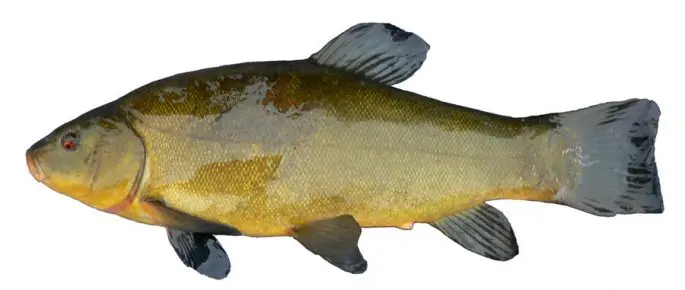
The body of the tench is covered with a thick layer of mucus, shortened, thick and tall. The scales are quite small and from 90 to 120 scales can be counted along the lateral line. If you look closely at the tench, then the color of its scales seems greenish and even olive. If you get rid of the mucus in any way, then the color of the scales will be completely different. In fact, the scale color of the tench is yellowish with various shades. Slime plays its role here, masking the real color of tench. Depending on the nature of the reservoir, the color of the tench can vary from light yellowish-sand tones to almost black. In reservoirs with silty soil or in peat quarries, the tench color will be dark, but in rivers and lakes with a sandy bottom, the tench will have light colors.
Interesting fact! This fish got its name from the fact that the mucus, in the process of drying, then falls off the fish. It looks like the fish is shedding.
There is another version of the name of the fish. Since tench leads a sedentary lifestyle, many believe that its name comes from the word “laziness”. Over time, this word was transformed into the word “lin”.
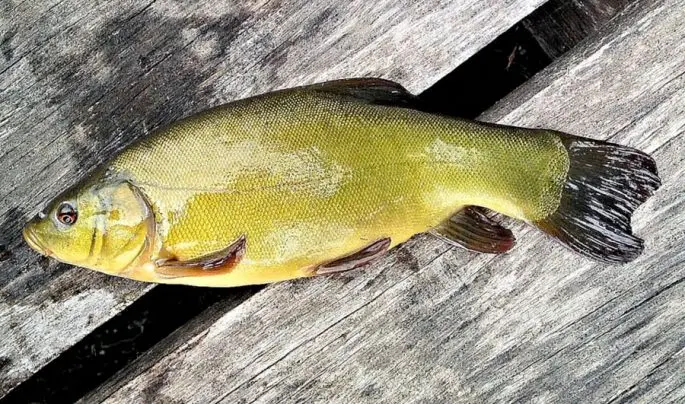
The fish has other distinctive features. For example:
- Dimensions: on average, tench grows up to 40 cm in length, although individuals up to 0,7 meters long can be found, with a weight of about 7,5 kg.
- The fins are somewhat shortened and also covered with mucus. At the same time, at the base, their color is the same as the color of the body, and towards the end they darken and become almost black. The caudal fin does not have a characteristic notch, so it looks almost even.
- The lips of the tench are fleshy and seem to be quite thick, while they have a lighter shade compared to the body.
- Small antennae can be seen in the corners of the mouth, which indicate that the tench is a relative of the carp.
- The eyes are quite small and deep set. They are reddish-orange in color.
- Sexual dimorphism has pronounced properties: The pelvic fins of males are much larger, in addition, males are smaller than females, since females grow much faster.
Interesting to know! In artificially bred golden tench, the color of the scales really matches the golden hue, and the eyes are darker compared to its natural counterpart.
Behavior and lifestyle
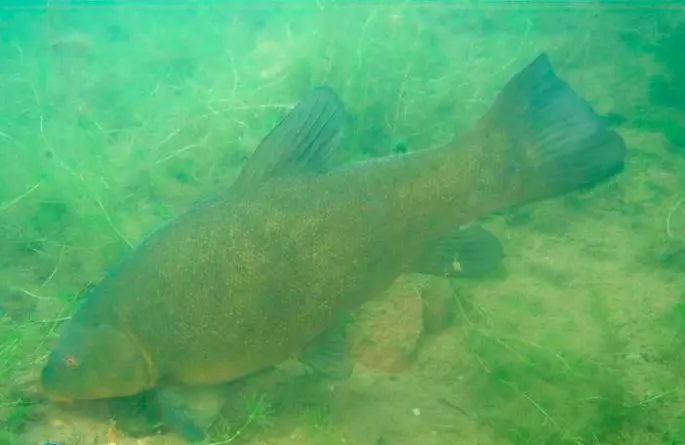
Almost everyone knows that cyprinids are distinguished by swiftness and strength. As for the tench, you can’t say the same about it, since it is a calm and slow fish. In addition, the tench is distinguished by caution and shyness, so catching a tench is not always easy. If he falls for the bait and they try to pull him out of the water, then the tench begins to resist strongly and often he manages to get off the hook. This is especially true for trophy specimens.
Older individuals lead a solitary way of life, in comparison with juveniles, which form a few flocks of one and a half dozen individuals. Tench comes out to hunt in the dark. This is due to the fact that he does not tolerate sunlight, so during the day he tries to stay in his shelter.
It is important to know! Although tench is considered a sedentary fish, it makes daily feeding migrations, moving from depth to shore and vice versa. In addition, during the spawning period, fish are able to move long distances in search of suitable spawning sites.
With the advent of late autumn, the tench burrows into the silt and falls into a state of suspended animation. In the spring, when the water can warm up to +4 degrees, the lines wake up and go to the coastal zone, overgrown with aquatic vegetation. Feeding tench paths are located on the border of clear water and thickets of aquatic vegetation or grass. In the middle of summer, when especially hot weather sets in, the tench becomes passive and tries to stick to areas with considerable depth, where it is possible to hide from the heat on the bottom. As the water in the reservoirs cools, the activity of tench increases.
How long does a tench live
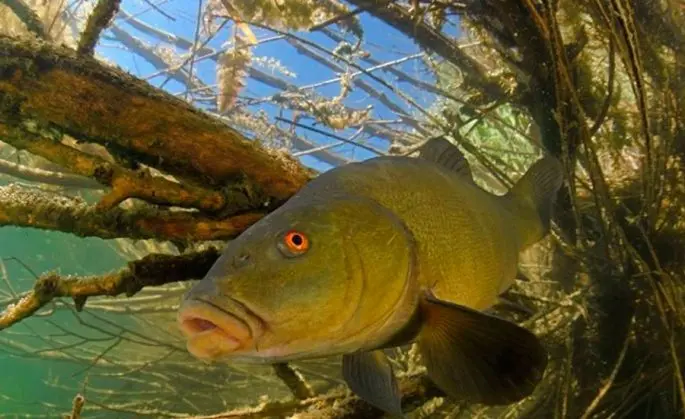
Tench can live for a maximum of about 16 years, and after 7 years of life, its growth stops.
Range, habitats
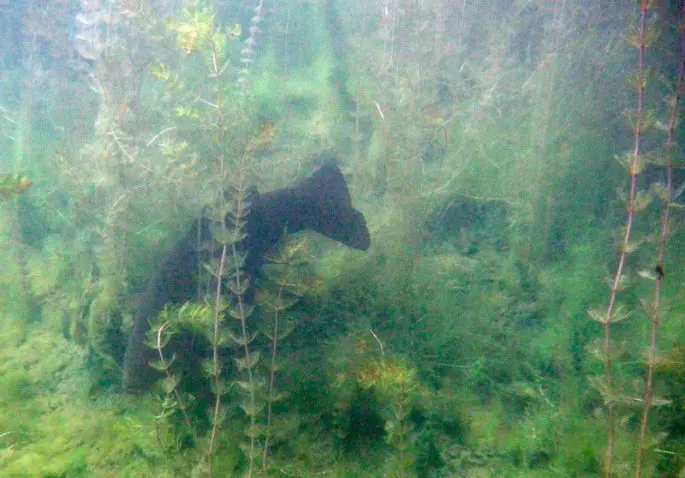
Tench is a heat-loving fish that settles in warm water bodies, mostly with stagnant water and a quiet current. Its habitat covers some European countries and Asian countries located in a temperate climate. Tench, like crucian carp, is not sensitive to a decrease in the level of oxygen in water bodies, therefore they can easily live in swamps or estuaries overgrown with aquatic vegetation, where the bottom is very muddy.
In reservoirs where there is a clean sandy or rocky bottom, as well as cold water with a fast current, tench is almost never found.
Interesting fact! Tench feels comfortable in conditions when both low-growing and high-growing algae predominate in the reservoir. In such places, the tench obtains food for itself, and also hides from natural enemies.
Depending on the habitat conditions, the fish may differ in appearance, although not significantly. In this regard, the fish is divided into four subspecies. For example:
- tench lake. Prefers to live in large lakes and reservoirs.
- tench pond. For their life, they choose small water bodies, both natural and artificial.
- tench river. It prefers to settle in the backwaters of rivers or their channels, as well as in their bays and branches. It differs in that this subspecies is somewhat thinner than the previous two, in addition, it has a slightly curved upward mouth.
- Tench pygmy. This subspecies prefers conditions when there is an excess of fish in the reservoir, therefore, in such conditions, it grows up to 12 cm in length. This species is considered the most common, since it settles in almost any reservoir.
World’s Biggest Fish Caught # 7.5kg Tench
Tench diet
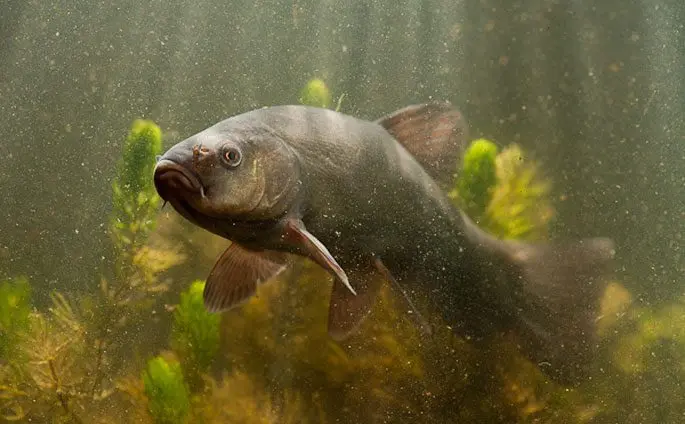
The basis of the tench’s diet is food of animal origin, but it is also able to switch to plant foods, especially in the summer. Since the fish is small, the objects of hunting are various invertebrates, mollusks, as well as insects and their larvae that are found within the reservoir. With the advent of spring, tench feeds with pleasure on young shoots of reeds, cattails, sedges, etc.
It is important to know! Tench is able to eat anything, so this fish is not critical to food objects.
Tench feeding places are easy to determine by the nature of the bottom of the reservoir, as well as by the presence of dense aquatic vegetation. To get food for themselves, tenches dig in the muddy bottom, causing air bubbles to rise from the bottom, which, in turn, gives out the location of this fish.
With the advent of autumn, when the water temperature drops noticeably, the tench begins to feed not as actively as in summer. With the advent of winter, tench does not feed at all, but burrows into silt and stays in similar conditions until spring.
With the onset of spring, when the water temperature becomes already comfortable for the tench, it begins to wake up and goes to feeding areas. During this period, lines successfully eat mosquito larvae.
Best biting period
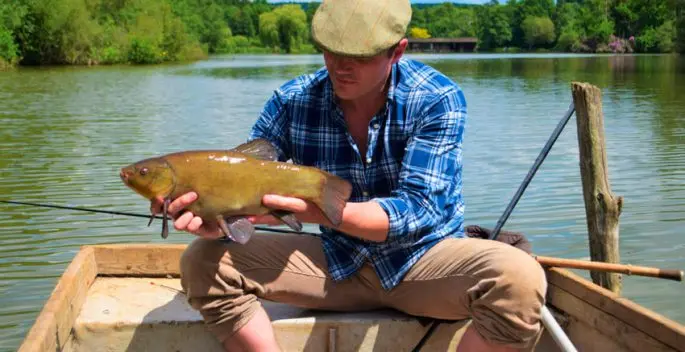
Before spawning in May, and then immediately after spawning comes zhor. Favorable conditions for fishing: moderately high turbid water and cloudy warm days. In established clear weather, it also takes well, but only in the morning and evening; during the day it bites only in those conditions when it feeds in thickets of aquatic plants or looks for food in the silt.
FISH LINCH on a FLOAT ROD – FEATURES OF FISHING on LIN
Reproduction and offspring
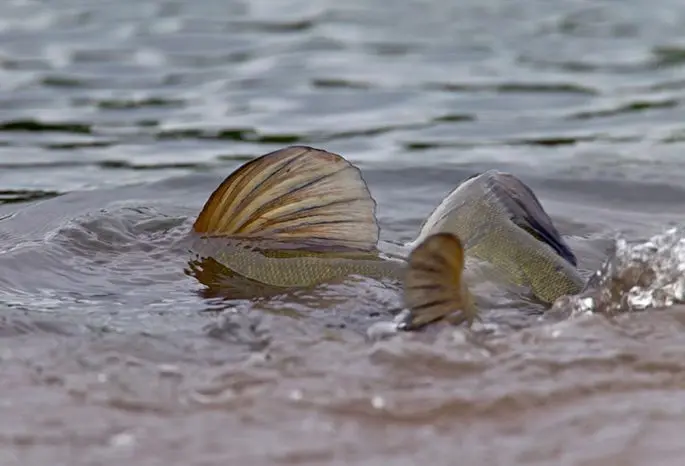
Tench is a heat-loving fish, and therefore spawns late, somewhere in late spring, early summer. For spawning, the fish chooses calm areas of the reservoir, with a slow current, and always with thickets of aquatic vegetation. Caviar is laid at a depth of 0,3-0,8 meters and is attached to the branches of trees or other vegetation lowered into the water, which grow near the shore.
Interesting fact! Spawning is carried out in several stages, with an interval of one or even two weeks. Individuals who have reached 3-4 years of life and have gained at least 200 grams in weight take part in this process. Depending on age, the number of eggs can reach different numbers, from 20 to 500 thousand pieces. At the same time, they ripen in record time, for some 3 days.
The tench fry that were born reach a length of no more than 3,5 mm. They remain on the substrate for several more days. All this time, the fry intensively feed on the remaining reserves of the yolk sac.
After the fry can swim on their own, they form numerous flocks and hide in aquatic vegetation. During this period, their diet includes animal plankton and unicellular algae. Having reached a length of about 1,5 cm, tench fry sink to the bottom, where more nutritious food awaits them, in the form of benthic organisms.
Natural enemies of lines
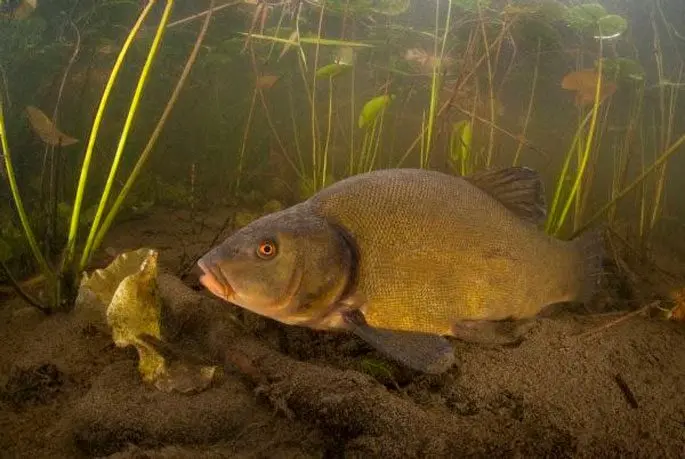
Adult individuals are practically not a source of food for predatory fish. This is due to the mucus that covers their body. Mucus is unpleasant for other fish, especially predatory ones, so they do not hunt adult tench. As for the young, it is a source of food for many predatory fish.
Number and status of the species
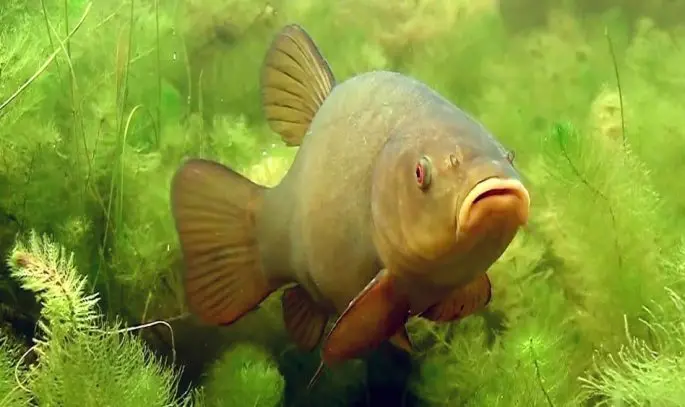
This fish is very widespread throughout Europe, but in our country the tench suffers greatly, both from poachers and from pollution of water resources. The anthropogenic factor has a rather strong influence on the abundance of many fish species, including tench.
There are cases when a person completely unconsciously causes significant damage to the number of fish. This is especially true when the water level drops sharply in the reservoirs in winter. Naturally, a person is involved in this process. And the consequences are often quite sad, since this leads to the death of fish wintering at the bottom of the reservoir.
It is important to know! In Germany, in the Irkutsk region, as well as in the Yaroslavl region and in Buryatia, lines are listed in the Red Book.
Despite such facts, the main population of tenches is beyond the threat for their further existence, therefore the species has been assigned the status of “causing the least concern”.
Fishing value
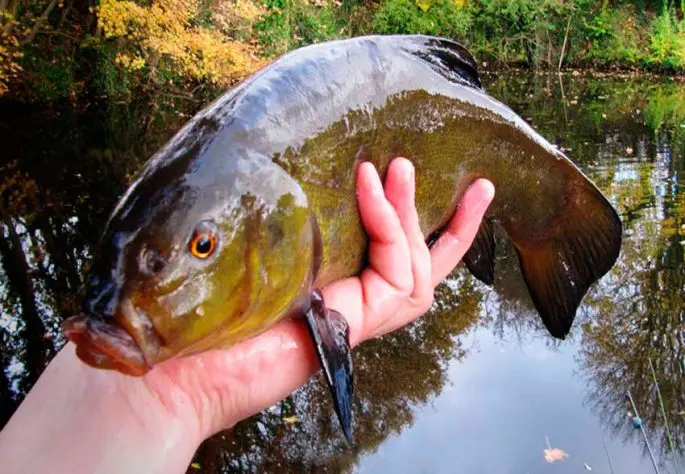
Tench is not considered a valuable commercial fish that can be harvested on a large scale in the natural environment. In such reservoirs, tench is more often caught by amateur fishermen. This fish is bred on a large scale in fish farms and this is due to the unpretentiousness of this type of fish. They can easily live in conditions where carp simply cannot survive.
Tenches prefer to lead a benthic lifestyle, while they move in the water column quite slowly compared to other fish species. At the same time, the fish has unique abilities. Firstly, the eggs ripen quickly enough, which takes only 3 days. Secondly, the presence of a layer of mucus allows the lines to defend themselves against natural enemies. Apparently, this is why the fish moves so slowly, knowing that it is not of interest to predators as a food object.
Tenches get sick much less often compared to other fish, as the mucus contains natural antibiotics.
For many centuries, people have truly appreciated the taste of fish. More recently, tench was called the “royal fish.” The same attitude continues to this day. From tench meat, you can cook any, moreover, delicious fish dishes, especially at home. Given that a rather weighty specimen can get on the hook, many anglers catch tench.
In conclusion
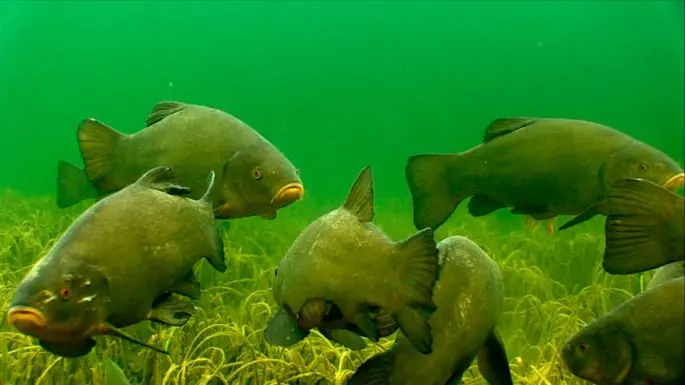
There are several nuances that will help you choose the right fish for cooking. After all, fresh tench can be stored for no more than 3 days, and then it must be gutted before storage. Cooked fish is stored much longer, at a temperature not higher than +5 degrees. And yet, first of all, you need to buy it in the market or in a store, as well as fresh from your hands. Well, if the family has its own fisherman, then there can be no problems with the freshness of the fish. If you want to buy fish, then you need to carefully examine it. First, the fish’s eyes should look fresh and clear. Secondly, you can put pressure on the fish. If a dent remains after this, then the fish is stale. Never take the seller’s word for it. If the fish is fresh, then its surface is elastic and the dent disappears before our eyes. There are cases when, when buying a fish, and then when cutting it, the meat easily falls off the bones. In this case, the fish must either be returned to the seller, or thrown into the trash can: it definitely should not be eaten.
Tench is such a unique fish that it has left its mark on the cultures of some peoples. In Hungary, this fish is not valued at all, which is why it is called “gypsy fish” there. Despite such facts, some peoples attributed healing properties to the tench. This happened in ancient times. Then people believed that if the line is cut in half and applied to the wound, the wound will heal quickly, the pain will go away and the fever will decrease. In those days, they believed that fish could easily rid a person of jaundice. At the same time, the tench also has a positive effect on other fish. It was enough for sick fish to simply rub against this fish and the disease would be removed as if by hand.
It is also worth noting the beneficial properties of tench. 100 grams of meat of this fish contains only 40 kcal, which makes it indispensable as a dietary product. The composition of the meat contains a whole bunch of useful components, such as vitamins, minerals, high-quality protein, as well as polyunsaturated fatty acids. Due to the presence of high-quality protein containing essential amino acids, doctors advise eating this fish regularly.
Tench fish is suitable for preparing a wide variety of dishes. At the same time, it must be remembered that fish caught during the spawning period is not suitable for cooking. The highest taste qualities are observed before the start of spawning, and this is the month of April or May. This fact is due to the fact that the fish prefers to live in not quite clean water, which can smell like a swamp. But, if still live fish is placed in the bathroom for 12 hours, then the problem can be solved. If the tench is cooked correctly, then its taste can be compared with the taste of chicken meat.
Float fishing. LIN’S BITS.









